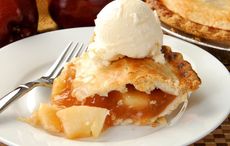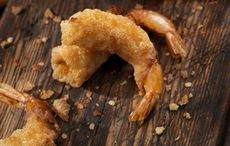Saint Patrick was a gentleman Who through strategy and stealth Drove all the snakes from Ireland Here's a drinkee to his health! But not too many drinkees Lest we lose ourselves and then... Forget the good Saint Patrick And see them snakes again! Good grief, here we go again, it's Corned Beef Day When I was growing up, my dad's favorite on St. Patrick's Day was boiled bacon and cabbage and it would appear that is still true in Ireland today. The "bacon joint"- various cuts of salted or smoked and salted pork - is sometimes cooked alone, or it might be braised with a small chicken keeping it company in the pot; it might also be served with vegetables, or with potatoes boiled in their jackets. For holiday eating, the winner would probably be spiced beef, served cold and sliced thin, with soda bread and a pint of Guinness on the side. At our house, we always had Roast Goose at Christmas and Roast Lamb on Easter. In fact, the first time I ever ate Corned Beef & Cabbage was after I came to the U.S. So what will people in Ireland be eating on St. Patrick's Day? The question was put to listeners of South East Radio which reaches south Wicklow and parts of Wexford and Kilkenny. Said one respondent: "Eat? I eat pints." Another referred to the pint of Guinness as a "shamrock sandwich" and one mentioned a dish her family sometimes made which used cabbage, turnip and potatoes to honor the colors of the Irish flag. Of the twenty-five people who were polled, none of them mentioned any specific food as being of any interest. According to the U.S. department of Agriculture Originally "Corned Beef and Cabbage" was a traditional dish served for Easter Sunday dinner in rural Ireland. The beef, because there was no refrigeration at that time was salted or brined during the winter to preserve it, it was then eaten after the long, meatless Lenten fast. However other Irish people feel that corned Beef and cabbage is about as Irish as spaghetti and meatballs. That beef was a real delicacy usually served only to the kings. According to Bridgett Haggerty of the Web site Irish Cultures and Customs she says that their research shows that most likely a "bacon joint" or a piece of salted pork boiled with cabbage and potatoes would more likely have shown up for an Easter Sunday feast in the rural parts of Ireland. Since the advent of refrigeration, the trend in Ireland is to eat fresh meats. Today this peasant dish is more popular in the United States than in Ireland. Irish-Americans and lots of other people eat it on St. Patrick's Day, Ireland's principal feast day, as a nostalgic reminder of their Irish heritage. Corning is a form of curing; it has nothing to do with corn. The name comes from Anglo-Saxon times before refrigeration. In those days, the meat was dry-cured in coarse "corns" of salt. Pellets of salt, some the size of kernels of corn, were rubbed into the beef to keep it from spoiling and to preserve it. Today brining - the use of salt water - has replaced the dry salt cure, but the name "corned beef" is still used, rather than "brined" or "pickled" beef. Commonly used spices that give corned beef its distinctive flavor are peppercorns and bay leaf. Of course, these spices may vary regionally. So here goes my recipe for: CORNED BEEF AND CABBAGE INGREDIENTS 4-pound corned beef brisket - 'silverside' if you can get it; many butchers are familiar with the term and can prepare your cut of brisket in this special way. But, do allow them several days to prepare it properly. 3 large carrots cut into large chunks 6 to 8 small onions, roughly chopped 1 teaspoon powdered English mustard 1 large spring of fresh thyme and several parsley stalks tied together 1 cabbage Salt and pepper to taste METHOD 1. Put the corned beef into a large pot with the carrots, onions, mustard powder and herbs. 2. Cover with cold water; bring to a boil and then lower heat and simmer for 1 hour. From time to time, skim fat from top as it rises. 3. Discard the outer leaves of the cabbage and cut into quarters, Add to the pot. * Cook for another one to two hours or until the meat and vegetables are tender. 4. Serve the corned beef cut into slices and surrounded by the vegetables. Serve with a generous amount of potatoes, boiled in their jackets and freshly made mustard. (We use Colman's which is readily available). In addition to the English mustard we also like the following horseradish sauce: Horseradish Sauce 1/2 pt Whipping Cream 2 tablespoons prepared horseradish Whip cream until it stand in peaks. Fold in horseradish. AND FINALLY... GOOD GRIEF - NOT BEEF! I just want to put something straight About what should be on your plate, If it's corned beef you're makin' You're sadly mistaken, That isn't what Irishmen ate. If you ever go over the pond You'll find it's of bacon they're fond, All crispy and fried, With some cabbage beside, And a big scoop of praties beyond. Your average Pat was a peasant Who could not afford beef or pheasant. On the end of his fork Was a bit of salt pork As a change from potatoes 'twas pleasant. This custom the Yanks have invented, Is an error they've never repented, But bacon's the stuff That all Irishmen scoff, With fried cabbage it is supplemented. So please get it right this St. Paddy's. Don't feed this old beef to your daddies. It may be much flasher, But a simple old rasher, Is what you should eat with your tatties. May the holes in your net be no larger than the fish in it. CHEF GILLIGAN




Comments